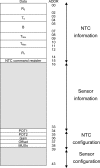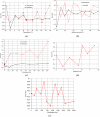A programmable plug & play sensor interface for WSN applications
- PMID: 22164118
- PMCID: PMC3231495
- DOI: 10.3390/s110909009
A programmable plug & play sensor interface for WSN applications
Abstract
Cost reduction in wireless sensor networks (WSN) becomes a priority when extending their application to fields where a great number of sensors is needed, such as habitat monitoring, precision agriculture or diffuse greenhouse emission measurement. In these cases, the use of smart sensors is expensive, consequently requiring the use of low-cost sensors. The solution to convert such generic low-cost sensors into intelligent ones leads to the implementation of a versatile system with enhanced processing and storage capabilities to attain a plug and play electronic interface able to adapt to all the sensors used. This paper focuses on this issue and presents a low-voltage plug & play reprogrammable interface capable of adapting to different sensor types and achieving an optimum reading performance for every sensor. The proposed interface, which includes both electronic and software elements so that it can be easily integrated in WSN nodes, is described and experimental test results to validate its performance are given.
Keywords: TEDS; embedded microcontroller; plug & play; sensor interface; smart sensors; wireless sensor networks.
Figures

















References
-
- Krishnamachari B. Networking Wireless Sensors. Cambridge University Press; New York, NY, USA: 2005.
-
- Bissi L, Placidi P, Scorzoni A, Elmi I, Zampolli S. Environmental monitoring system compliant with the IEEE 1451 standard and featuring a simplified transducer interface. Sens. Actuat. A Phys. 2007;137:175–184.
-
- Pal S, Rakshit A. Development of network capable smart transducer interface for traditional sensors and actuators. Sens. Actuat. A Phys. 2004;112:381–387.
-
- Kirianaki NV, Yurish SY, Shpak NO, Deynega VP. Data Acquisition and Signal Processing for Smart Sensors. John Wiley & Sons; Chichester, UK: 2002.
Publication types
MeSH terms
LinkOut - more resources
Full Text Sources

